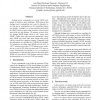Free Online Productivity Tools
i2Speak
i2Symbol
i2OCR
iTex2Img
iWeb2Print
iWeb2Shot
i2Type
iPdf2Split
iPdf2Merge
i2Bopomofo
i2Arabic
i2Style
i2Image
i2PDF
iLatex2Rtf
Sci2ools
VLSI
2005
Springer
2005
Springer
Pareto Points in SRAM Design Using the Sleepy Stack Approach
Leakage power consumption of current CMOS technology is already a great challenge. ITRS projects that leakage power consumption may come to dominate total chip power consumption as the technology feature size shrinks. Leakage is a serious problem particularly for SRAM which occupies large transistor count in most state-of-the-art chip designs. We propose a novel ultralow leakage SRAM design which we call “sleepy stack SRAM.” Unlike many other previous approaches, sleepy stack SRAM can retain logic state during sleep mode, which is crucial for a memory element. Compared to the best alternative we could find, a 6-T SRAM cell with highVth transistors, the sleepy stack SRAM cell with 2xVth at 110o C achieves more than 2.77X leakage power reduction at a cost of 16% delay increase and 113% area increase. Alternatively, by widening wordline transistors and transistors in the pull-down network, the sleepy stack SRAM cell can achieves 2.26X leakage reduction without increasing delay at a ...
| Added | 28 Jun 2010 |
| Updated | 28 Jun 2010 |
| Type | Conference |
| Year | 2005 |
| Where | VLSI |
| Authors | Jun-Cheol Park, Vincent John Mooney III |
Comments (0)

